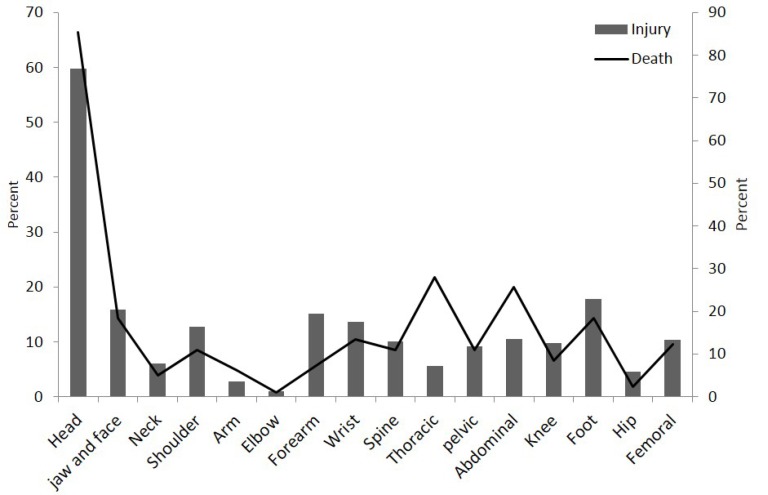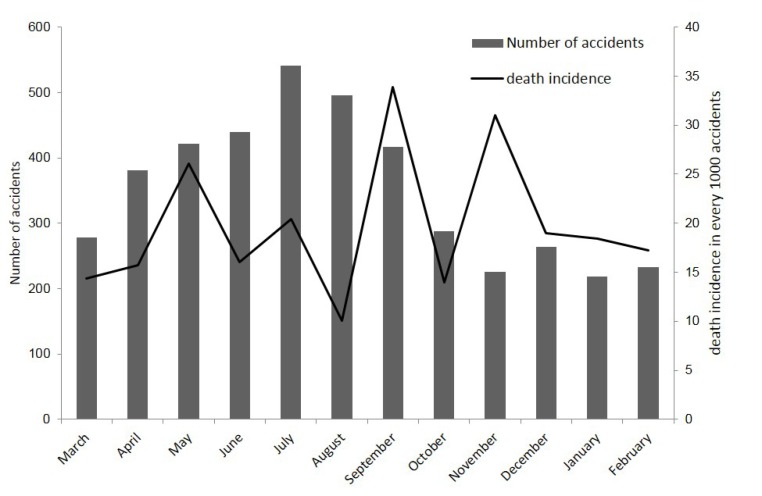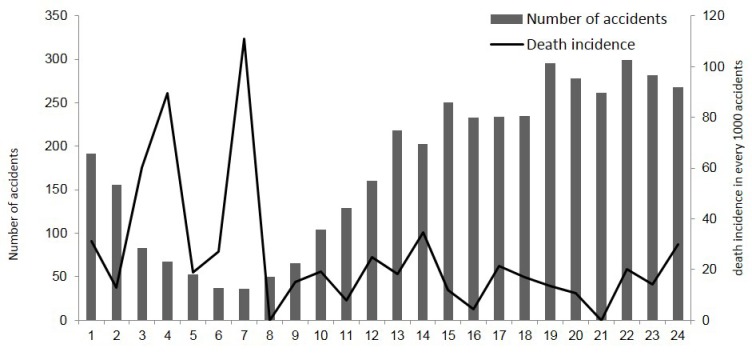Abstract
Background:
Motorcyclists are among the most vulnerable groups of road accident victims, who are prone to a growing mortality rate due to the constant rise in the number of accidents. This study was performed to investigate the injury patterns among motorcyclist trauma patients admitted to Kamyab Hospital, the largest trauma center affiliated with Mashhad Univercity of Medical Sciences, Mashhad, Iran, due to an accident.
Methods:
This cross-sectional study was conducted on motorcyclists referred to our hospital due to accidents from August 23, 2014 to August 22, 2016 to receive treatment. After the accurate examination of the collected data and correction of the potential errors, they were subjected to analysis. The gathered data included the demographic variables, injury pattern, accident time, and accident type. Data analysis was performed in Stata Software, version 12.
Results:
A total of 4,205 motorcycle accident cases were hospitalized (14% of all cases were hospitalized during the two-year study period). The mean age of the patients was 30 years, and 88% of them were male (a male to female ratio of 7.3). Car- and pedestrian-motorcycle collisions were the most common causes of injury that accounted for 68% and 22% of the cases, respectively. The head was the most commonly injured site of the body; in this regard, 59.7% of the admitted patients and 85.4% of total death cases had a head injury. In addition, 67% of the target population received trauma in more than two parts of their body. The elbow, arm, and hip were the least regions involved.
Conclusion:
Motorcycle accidents cause severe physical injuries to the patients’ body. Head injury was the most common type of trauma, leading to a wide range of disabilities. Therefore, the use of crash helmets and avoidance of dangerous driving behaviors will remarkably decrease such trauma.
Key Words: Injury, Motorcyclist, Trauma
Introduction
Road accidents are regarded as the most common type of accidents threatening the lives of many people annually (1). These accidents stand as the eighth cause of death; moreover, they are reported as the first cause of mortality in the age group of 15-29 groups. Accordingly, road traffic injuries are a major public health problem across the world (2). Annually, road accidents account for > 1.24, > 10, and 50 million cases of mortality, permanent disabilities, and injuries, respectively (3, 4).
According to the reports of the World Health Organization (WHO), the rate of road accidents in Iran exceeds the global average. This report places Iran among the countries with the highest road traffic death rate (1, 5). The rate of road accidents in Iran is 13 times more than the global average. In this regard, many people die or get injured each year as a result of these accidents (6). Industrialization has resulted in an increase in the rate of road accident death in Iran (30 to 39 cases per 100,000 people) (7).
The most fatal road accidents are those pertaining to motorcyclists.This type of vehicle is inherently unsafe and is increasingly used by the youths (8, 9). It is estimated that in Iran, about 30% of the motor vehicles are motorcycles (10). Motorcyclists are respectively prone to 30 and 9.3 times higher risk of accident and death, compared to other road drivers (11, 12). The description of the demographic features and details of the accidents are of utmost importance in the prevention, management, and analysis of road accidents. Regarding this and given the high mortality rate of motorcyclists in road accidents, the current study was conducted to describe the injury patterns and mortality rate of the motorcyclists admitted to Kamyab Hospital, the largest trauma center affiliated with Mashhad Univercity of Medical Sciences, Mashhhad, Iran (13).
Materials and Methods
The clearance for performing this study was provided by Mashhad University of Medical Sciences, Mashhad, Iran (No. 951654). All the road accidents pertaining to the motorcyclists, who were referred to our hospital from August 23, 2014 to August 22, 2016 and registered in the Iranian Hospital Information System, were included in this study. The received data were accurately checked and examined before analysis, potential errors were corrected, and upon obtaining accurate reliable data, an analysis was performed in Stata software (version 12).
The collected data included age, gender, time, type and site of trauma, mortality rate, and vehicle type. The quantitative variables were described as mean and standard deviation. In addition, the qualitative variables were presented as number and ratio in tables and figures. The relationship between age and the relevant outcome was examined using the t-test. A p-value less than 0.05 was considered statistically significant.
Results
During the period of the study, a total of 4,205 patients were referred to our hospital due to road accidents pertaining to motorcycles to receive treatment. The mean age of the patients was 30±8 years, and 88% of them were male, therefore rendering a male to female ratio of 7.3. Car- and pedestrian-motorcycle collisions were the most common causes of injury that accounted for 68.1% and 22.6% of the cases, respectively. Furthermore, 9.3% of the individuals were injured due to motorcycle overturn or collision of two motorcycles.
The youngest and oldest patients were 1 and 96 years old, respectively. There were 82 injury-related deaths during the study period resulting in a 2% mortality rate. The mean ages of the discharged and dead patients were 30±0.28 and 45±2.5 years, respectively, and this difference was statistically significant (P<0.001). In addition, the majority of the discharged patients belonged to the age group of 15-34 years, whereas the highest rate of mortality was seen in the age group of over 60 years [Table 1].
Table 1.
Demographic data
| Variables | category of variables |
discharged
|
Death
|
Total
|
|||
|---|---|---|---|---|---|---|---|
| number | percent | number | percent | number | percent | ||
| Age | 15< | 428 | 10.4 | 5 | 6.1 | 433 | 10 |
| 15-29 | 2028 | 49.4 | 20 | 24.4 | 2048 | 50 | |
| 30-44 | 957 | 23.3 | 18 | 21.9 | 975 | 23 | |
| 45-60 | 420 | 10.3 | 17 | 20.7 | 437 | 10 | |
| 60> | 273 | 6.6 | 22 | 26.9 | 295 | 7 | |
| total | 4106 | 100 | 82 | 100 | 4188 | 100 | |
| Sex | male | 3612 | 88 | 77 | 93.9 | 3698 | 88 |
| Female | 495 | 12 | 5 | 6.1 | 504 | 12 | |
| Total | 4107 | 100 | 82 | 100 | 4202 | 100 | |
Head was the most common injured site of the body. 59.7% of the admitted patients and 85.4% of total death cases had trauma to head. The leg, foot, and face were the next commonest trauma sites. 67.1% of the target population received traumas on more than two parts of their bodies. (Figure 1).
The head was the most commonly injured site of the body, followed by the foot, face, and forearm. In this regard, 59.7% of the admitted patients and 85.4% of total death cases had head injuries. Additionally, 67.1% of the target population had traumas in more than two regions of the body [Figure 1].
Figure 1.
frequency of body region injured in trauma
The findings of the current research showed that the upper and lower limbs trauma was observed in 78.8% and 60.9% of the cases, respectively. The elbow, arm, and hip were the least regions involved. The frequency distribution of the accidents was indicative of a variation in the frequency of the accidents across different months. In this respect, July and August accounted for the highest rate of accidents, and the highest death incidence rate (per 1000 accidents) occurred in September [Figure 2]. In terms of seasonal frequency, the highest rate was in the summer, while the lowest rate belonged to the winter. In addition, the majority of the accidents had occurred at 22:00, and the highest mortality rate belonged to the accidents which had happened at 7:00 a.m. [Figure 3].
Figure 2.
Distribution of accidents and mortality rate in different months of the year
Figure 3.
Frequency of accidents and mortality rate in different hours of a day
Discussion
The motorcyclists are among the most vulnerable groups of road accident victims. Given the inherent unsafety of this type of vehicle and its growing usage by the youths, there has been an increase in the incidence of road accidents involving these road users (14). In this study, 60% of the trauma cases were observed in the age group of 15-34 years with a mean age of 30 years. Similar studies have also shown that motorcycle accidents mostly happen among individuals of younger age group. The mean age is reportedly fluctuating between 22 and 31 years of age (8, 15-17).
The relatively low price of motorcycles, compared to cars, in low-income countries has been the reason for the constant increase in using these vehicles by the youths. On the other hand, the lack of experience, sense of excitement, and false self-confidence in the youths increase the risk of accidents in this age group.
The male to female ratio of 7.3 observed in the study population demonstrates a higher risk of injury among males than females. In Iran, women are not licensed to drive motorcycles. Furthermore, men are far more involved in occupational and recreational activities. Females constituted only 6% of injury-related death cases indicating the considerably higher incidence of fatal trauma in men (8, 15-17). In the current study, the head was the most commonly injured body region, followed by the leg and face.
The most commonly injured body regions that have been reported in the literature are the head, neck, thorax, and extremities, the most fatal of which was head trauma. Likewise, more than 80% of the dead patients in this study had head trauma. In a study carried out in Gilan province, Iran, it was shown that the head and neck traumas accounted for 83% of cases, while face traumas were observed in 14% of the cases (18). In a study conducted in the United States, Sosin et al. reported 53% of total death cases were caused by head trauma (19). In addition, lower extremities traumas were more frequent than the injuries of the proximal part and upper extremity.
Most of the accidents happened in the summer (i.e., in July, August, and June in order of frequency). Similar studies have also demonstrated this seasonal incidence (14, 20, 21). People tend to use motorcycles in hot weather more often; therefore, the increase in using this vehicle in the summer heightens the number of accidents in this season.
The majority of the accidents had occurred at 22:0; however, the highest mortality rate belonged to the accidents having occurred at 7:00. Death risk has been reported to be 2-3 times higher in the accidents taking place in the early hours of a day in different studies (22-24). The reason for the higher death incidence at early hours in the morning may be the less strict traffic control and the lighter traffic, which, in turn, urges the drivers to move faster, resulting in a rise in the death risk at accidents.
The crash helmet decreases the incidence and severity of traumas in motorcyclists. Those who do not wear such helmets are at a higher risk of receiving severe head trauma, compared to the cyclists with helmets (25, 26). In addition to death, road accidents cause disabilities, injuries, and high costs. The disabilities and injuries resulting from road accidents are respectively 8 and 40 times more common than the death cases (3, 4, 27). The annual financial costs caused by such accidents are estimated to be 500 billion dollars (28).
Motorcycle accidents lead to severe physical injuries. In the current study, head injury was recorded as the most common type of trauma, leading to a wide range of disabilities. Therefore, the use of motorcycle helmets and avoidance of dangerous driving behaviors will remarkably decrease such traumas.
Conflicts of interest:
No conflict of interest has been declared by the authors of the present study.
References
- 1.Yonesian M, Moradi A. Knowledge, attitude and practice of drivers on regulation of traffic in Tehran. J Sch Public Health Instit Public Health Res. 2005 [Google Scholar]
- 2.World Health Organization. available from. http://wwwwhoint/gho/road_safety/mortality/number_text/en.
- 3.Soori H, Hussain SJ, Razzak JA. Road safety in the Eastern Mediterranean Region--findings from the Global Road Safety Status Report. Eastern Mediterranean health journal = La revue de sante de la Mediterranee orientale = al-Majallah al-sihhiyah li-sharq al-mutawassit. 2011;17(10):770–6. doi: 10.26719/2011.17.10.770. [DOI] [PubMed] [Google Scholar]
- 4.Organization WH. The global burden of disease: 2004 update. 2008. [Google Scholar]
- 5.Tefft BC. Impact speed and a pedestrian’s risk of severe injury or death. Accident; analysis and prevention. 2013;871:8. doi: 10.1016/j.aap.2012.07.022. [DOI] [PubMed] [Google Scholar]
- 6.Jouybari L, Sanagoo A, Gadimi A, Tahanian M, Sabzi Z. The knowledge and attitudes of driving license trainee of first aids for the victims of road accidents. Journal of Gorgan Bouyeh Faculty of Nursing & Midwifery. 2010;7(1):41–7. [Google Scholar]
- 7.Bahadorimonfared A, Soori H, Mehrabi Y, Delpisheh A, Esmaili A, Salehi M, et al. Trends of fatal road traffic injuries in Iran (2004-2011) PloS one. 2013;8(5):e65198. doi: 10.1371/journal.pone.0065198. [DOI] [PMC free article] [PubMed] [Google Scholar]
- 8.Heydari ST, Maharlouei NN, Foroutan A, Sarikhani Y, Ghaffarpasand F, Moafian G, et al. Fatal motorcycle accidents in Fars Province, Iran: a community-based survey. Chinese journal of traumatology. 2012;15(4):222–7. [PubMed] [Google Scholar]
- 9.Patel PB, Staley CA, Mehta S, Schenker ML. Unhelmeted Motorcycle Riders Have Increased Injury Burden: A Need to Revisit Universal Helmet Laws. The Journal of surgical research. 2019;242:177–82. doi: 10.1016/j.jss.2019.03.023. [DOI] [PubMed] [Google Scholar]
- 10.Saadat S, Rahmani K, Moradi A, Zaini SA, Darabi F. Spatial analysis of driving accidents leading to deaths related to motorcyclists in Tehran. Chinese journal of traumatology = Zhonghua chuang shang za zhi. 2019 ;22(3):148–54. doi: 10.1016/j.cjtee.2018.12.006. [DOI] [PMC free article] [PubMed] [Google Scholar]
- 11.Horswill MS, Helman S. A behavioral comparison between motorcyclists and a matched group of non-motorcycling car drivers: factors influencing accident risk. Accident Analysis & Prevention. 2003;35(4):589–97. doi: 10.1016/s0001-4575(02)00039-8. [DOI] [PubMed] [Google Scholar]
- 12.Lin M-R, Kraus JF. Methodological issues in motorcycle injury epidemiology. Accident Analysis & Prevention. 2008;40(5):1653–60. doi: 10.1016/j.aap.2008.05.005. [DOI] [PubMed] [Google Scholar]
- 13.Injuries WHO, Department VP, Organization WH, Injuries WHODo, Prevention V. The injury chart book: A graphical overview of the global burden of injuries. World Health Organization; 2002. [Google Scholar]
- 14.Khorshidi A, Ainy E, Soori H. Epidemiological pattern of road traffic injuries among Iranian motorcyclist in 2012. Safety Promotion and Injury Prevention. 2016;4(1):47–54. [Google Scholar]
- 15.Lopez-Alvarenga J, Vazquez-Velazquez V, Arcila-Martínez D, Sierra-Ovando A, González-Barranco J, Salín-Pascual R. Accuracy and diagnostic utility of the Hospital Anxiety and Depression Scale (HAD) in a sample of obese Mexican patients. Revista de investigacion clinica; organo del Hospital de Enfermedades de la Nutricion. 2002;54(5):403–9. [PubMed] [Google Scholar]
- 16.Zargar M, Khaji A, Karbakhsh M. Pattern of motorcycle-related injuries in Tehran, 1999 to 2000: a study in 6 hospitals. Eastern Mediterranean health journal = La revue de sante de la Mediterranee orientale = al-Majallah al-sihhiyah li-sharq al-mutawassit. 2006;12(1-2):81–7. [PubMed] [Google Scholar]
- 17.Araqi E, Vahedian M. Study on susceptible and damages from motorcycle accidents in Mashhad in 2005. The Horizon of Medical Sciences. 2007;13(1):34–9. [Google Scholar]
- 18.Hemmati H, Chabok SY, Dehnadimoghadam A, Melksari HM, Dafchahi MA, Shabani S. Trauma in Guilan (North of Iran): an epidemiologic study. Acta Medica Iranica. 2009;47(5):403–8. [Google Scholar]
- 19.Sosin DM, Sacks JJ, Holmgreen P. Head injury-associated deaths from motorcycle crashes Relationship to helmet-use laws. Jama. 1990 ;264(18):2395–9. [PubMed] [Google Scholar]
- 20.Zohrevandi B, Asadi P, Monsef Kasmaee V, Tajik H, Ashouri A, Ebrahimi H. Epidemiology of motor cycle accidents in Rasht, 2011-2012. Iranian Journal of Forensic Medicine. 2014;20(4):169–70. [Google Scholar]
- 21.Ramouz A, Hosseini M, Vahdati SS. Epidemiology of head and neck fractures caused by motorcycle accidents. Iranian journal of emergency medicine. 2016;3(1):23–7. [Google Scholar]
- 22.Vorko-Jovic A, Kern J, Biloglav Z. Risk factors in urban road traffic accidents. Journal of safety research. 2006;37(1):93–8. doi: 10.1016/j.jsr.2005.08.009. [DOI] [PubMed] [Google Scholar]
- 23.Li Y-M. Road traffic casualties and risky driving behavior in Hualien County, 2001–2005. Tzu Chi Medical Journal. 2007;19(3):152–8. [Google Scholar]
- 24.Hasani J, Hashemi Nazari SS, Khorshidi A, Shojaei A. Factors related to pedestrians mortality following road traffic accidents in Tehran and Alborz Provinces, Iran. International Journal of Epidemiologic Research. 2016;3(3):204–13. [Google Scholar]
- 25.Kraus JF, Peek C. The impact of two related prevention strategies on head injury reduction among nonfatally injured motorcycle riders, California, 1991-1993. Journal of neurotrauma. 1995 Oct;12(5):873–81. doi: 10.1089/neu.1995.12.873. [DOI] [PubMed] [Google Scholar]
- 26.Bachulis BL, Sangster W, Gorrell GW, Long WB. Patterns of injury in helmeted and nonhelmeted motorcyclists. American journal of surgery. 1988 ;155(5):708–11. doi: 10.1016/s0002-9610(88)80151-x. [DOI] [PubMed] [Google Scholar]
- 27.Maracy M, Tabar Isfahani M. The burden of road traffic injuries in Isfahan, Iran in 2010. Journal of Kerman University of Medical Sciences. 2013;20(5) [Google Scholar]
- 28.Pfortmueller CA, Marti M, Kunz M, Lindner G, Exadaktylos AK. Injury severity and mortality of adult zebra crosswalk and non-zebra crosswalk road crossing accidents: a cross-sectional analysis. PloS one. 2014;9(3):e90835. doi: 10.1371/journal.pone.0090835. [DOI] [PMC free article] [PubMed] [Google Scholar]





